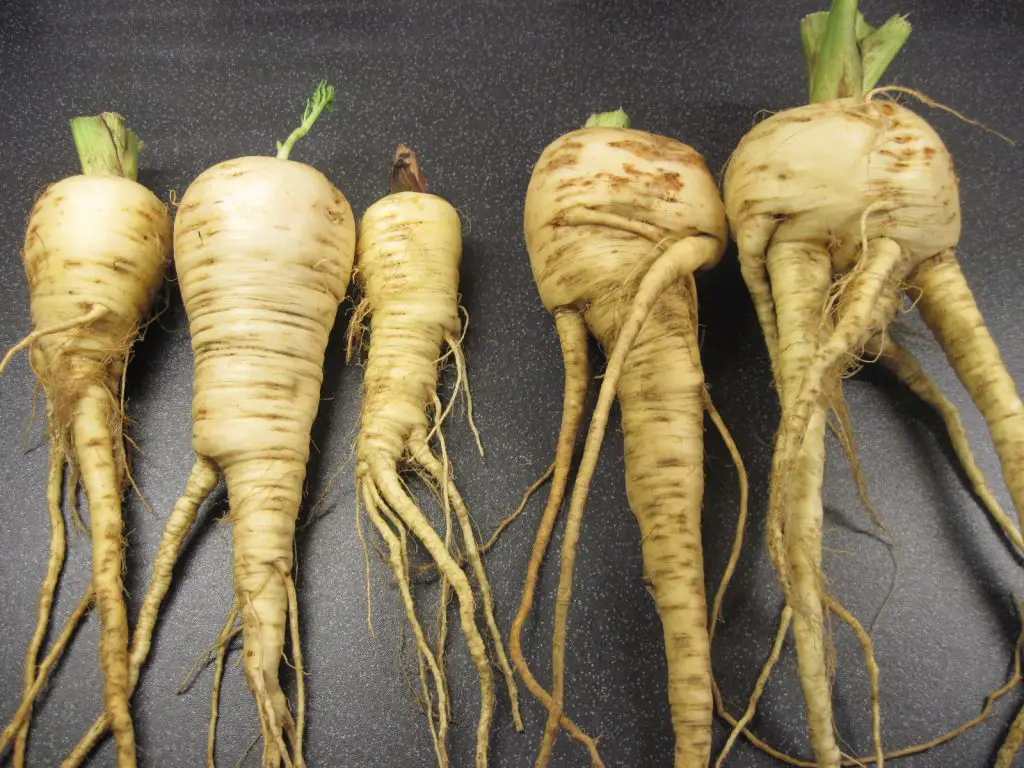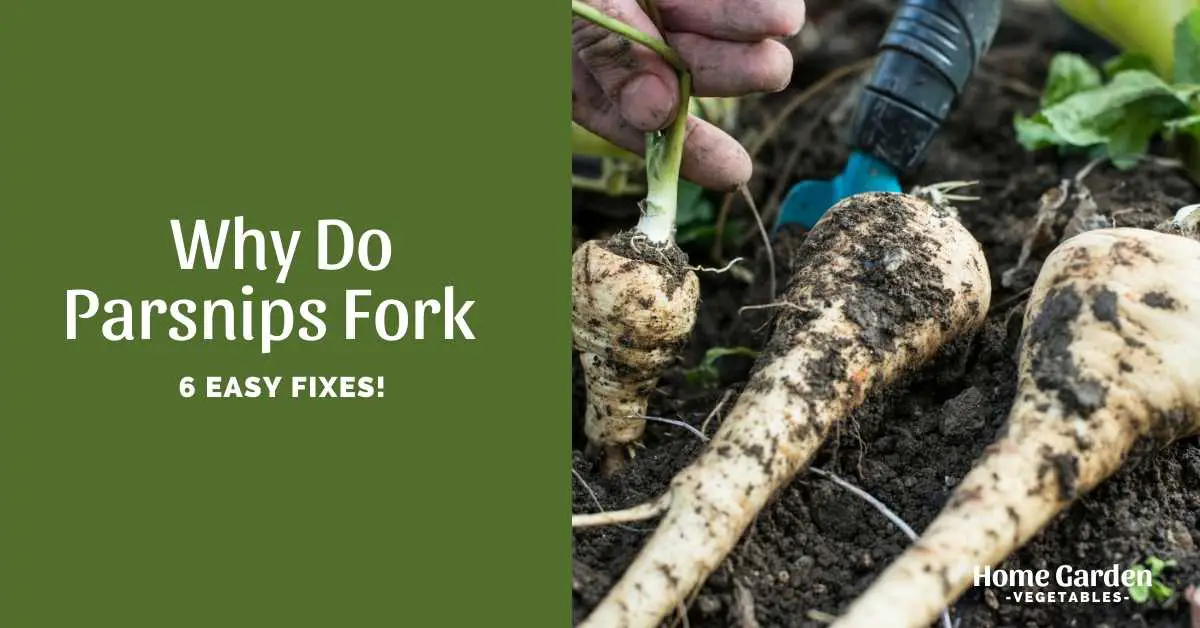Parsnips are healthy winter vegetables, closely related to parsley and carrots, with cream-colored roots that work perfectly in roasts, soups, stews, and even fries! Though they’re nutritious and flavorful, parsnips aren’t the easiest vegetables to grow. They’re slow to germinate and are a bit particular about their growing conditions. If they don’t find the right environment to grow in, you’ll find deformities in the roots, like forking.
Why do parsnips fork? Is there any way you can prevent it and harvest the perfect roots each time? Continue reading, and you’ll find out everything there is to know.
Reader Poll: What online courses would interest you?
What Is Forking On Parsnips?
Forking on parsnips is when the parts above the ground appear perfectly normal, but the roots are deformed and forked. Other than the extensive branching, the roots are well developed and firm.

Are Forked Parsnips Edible?
Forking in parsnips is merely an external flaw. Other than the unappealing shape of the roots, you won’t find anything wrong with the flavor, texture, or nutritional value. If you’re growing them to sell to the farmer’s market, deformities like forking will significantly diminish their market value.
However, if you’re simply growing them for use in your own kitchen, forking isn’t that big of a problem. Though they make amusing pictures and are difficult to peel, they’re as good for cooking as the perfect, straight parsnips you find in vegetable sections of the grocery store.
Subscribe to our newsletter!
In short, your mutant parsnips are just as nutritious and flavorsome as the straight, slender ones. And since they’re not participating in a beauty pageant, toss them in stews, soups, and roasts, and you won’t even realize they were deformed to start with.
Why Do Parsnips Fork?
Though they’re absolutely edible, you still wouldn’t want to miss the happiness in pulling out perfect roots at harvest time. The key to perfect harvests is to find out what caused the problem in the first place so you can rectify it in the next growing season.
Here are some reasons why your parsnips might be forked:
Unsuitable Soil Structure
Parsnips, like most root vegetables, like to grow in light, friable soil. Loamy or sandy soil, rich in organic material, is perfect to start your parsnips with. If you’re getting forked parsnips, one of the most common reasons is heavy, compacted soil or a rocky one. With heavy soil or rocks obstructing their development, roots find it challenging to grow straight down into the soil and turn out short and branched.
Solution
Prevent distorted roots by tilling and sifting the garden bed to about 12 inches, removing any stones, sticks, or large solid structures that you find along the way. If you have heavy clay soil, amend it with aged-compost and sand to improve soil structure to promote straight parsnips. If you don’t have the best soil in your garden, another solution is to grow your veggies in a raised bed prepared with packed soil and sand.
Too Much Nitrogen
It might be hard to believe, but incorrect fertilization can also result in forked parsnips. The use of high-nitrogen fertilizers, especially right after you’ve sown the parsnip seeds, can also result in the deformities that are bothering you. Parsnips don’t need as much nitrogen as most of your other garden plants.
Solution
For organic fertilization of your parsnip crop, select well-aged manure. Fresh manure has a higher content of nitrogen, which can result in forking and branching of roots. If you’re incorporating synthetic fertilizers, choose a low-nitrogen feed, for example, 5-10-10 fertilizer.
Transplanting
Transplanting parsnips can also be one of the causes of deformities. Transplanting root vegetables, especially those with long taproots, is never a good idea. That’s because root vegetables are very sensitive to such disturbances.
Solution
Avoid transplanting parsnips. Sow the seeds directly in the garden or container as soon as the soil temperatures are higher than 50°F. Leave them growing in the same spot until they’re ready for harvest to avoid disturbing the roots.
Insufficient Spacing
Oddly shaped roots can also result from the inadequate spacing between the plants. Tight plantings can result in twisted and forked parsnips instead of the straight ones you’re looking for.
Solution
Once the seedlings develop their first true set of leaves, thin them to 3 to 4 inches apart. This will allow plenty of space for each root to develop freely, without being obstructed by its neighbors.
Weeds
Weeds in your garden bed is another common reason for deformed roots. Since weeds have their own underground root system that competes for nutrients against your crop, it’s not surprising to find forked parsnips in a weedy garden.
Solution
Keep your garden weed-free throughout the growing season, so the unwanted roots don’t disturb the development of your parsnips.
Root-Knot Nematodes
Root-knot nematodes can also result in knotty, forked parsnip roots. They are microscopic worms that feed on the plants, leaving galls on the roots. These galls or knots prevent the plant from accessing water and nutrients to its fullest capacity, stunting the growth.
Solution
Select root-knot nematode-resistant parsnip seeds to prevent the problem right from the start. With certified nematode-free parsnip seeds, you can be sure you won’t find this disease in your crop. Also, since root-knot nematodes are less active during the winters, overwintering parsnips is also a good idea to prevent the damage done by these pests.
Can You Grow Parsnips In Clay Soil?
Yes you can grow parsnips in clay soil. You can use the clay to your advantage. Here are the steps to follow:
- Use a metal pole or broomstick
- Push the pole into the soil to a depth of 1 foot.
- Wiggle the pole round and round
- You want to make a cone shaped V in the ground up to 6″ wide
- Fill the hole with compost
- Put two parsnip seeds on top
- After the seeds have germinated remove the weakest
That’s it easy
Tips to Grow Parsnip Roots in Your Garden
Here are some useful and easy tools to grow parsnip roots in your garden.
- Use Fresh Parsnip Root Seeds
Parsnip seed is only viable for two years at best, and generally just one year. This is one seed that you should not save any leftovers of, therefore buy a new seed every year.
- Prepare The Soil
The parsnip grows the best on sweet soil, which has a pH of 6.0 or above. If your soil is acidic, lime it before planting parsnips in the winter.
Parsnips prefer a soil that is free of stones, light, and rich, but not the one that has just been manured. Make a hole in the earth about 2 ins wide and a foot deep with an iron bar or large dibber to provide perfect growth conditions for the parsnips. Fill this with high-quality compost. To keep the compost light, you can add sand to the mix.
- Soak The Seeds
Soaking parsnip seed for a couple of hours in a solution prepared by mixing one liter of lukewarm water with a soluble aspirin and cinnamon to enhance germination rate and prevent damping off difficulties for a couple of hours. Aspirin is chemically related to a growth hormone present in many plants, while cinnamon is a natural antifungal.
- The Right Time to Sow Seeds
Sow your parsnip seeds about 2 weeks before the last frost date. Parsnips have a long growing season, requiring an average of 110 days from seed to harvest.
- Sow Parsnip Directly Outdoors
Parsnips do not transfer well, so sow seeds directly. Station sowing is the ideal option because seeds of parsnip roots are not too small to handle. 3 to 5 seeds are put in a cluster half to an inch thick in sifted soil or compost and covered with sifting soil or compost. Water in gently.
- Choose Compost-Rich Soil
Parsnip roots thrive in soil that is rich in compost. Before planting, be sure to cover the soil with 2 inches of compost. Don’t work it into the soil; just sprinkle it on top. Wait a few days to a week before drawing 1/2-inch-deep rows in the dirt. Cover your seeds and sow them 1 inch apart.
- Water Regularly
Water thoroughly until seedlings emerge from the soil and take root. This phase should not be skipped because parsnips take around 3 weeks to germinate. This is especially true during the summer when it is hot and dry. When the earth dries out, the seeds dry up as well, preventing germination.
- Space Properly
Thin seedlings to 3 to 4 inches apart once they emerge. This spacing will allow the parsnip roots to grow to their full potential.
- Correct Time to Harvest
After frost, parsnip roots are ready to harvest in the fall. Parsnips can be planted and left in the ground until they are required. Cover the soil with a bale of straw to keep it from freezing. To further preserve the soil, cover the bale to prevent it from freezing to the ground, making harvesting simpler.
Conclusion
Though forking isn’t a significant problem, you now have your answer to why do parsnips fork. Follow all the tips to prevent forking and similar deformities and enjoy those picture-perfect parsnips you’ve been dreaming of.

